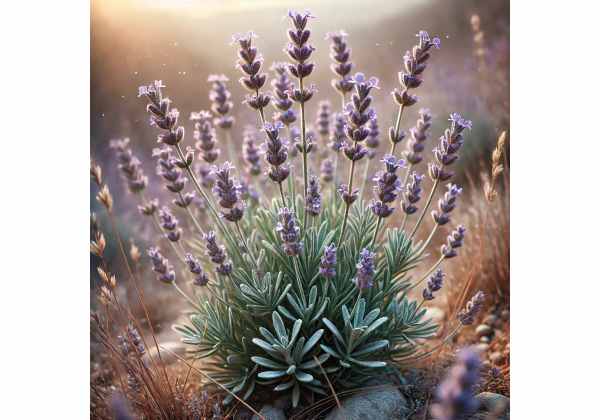Lavender is a versatile herb revered for its calming aroma, striking beauty, and powerful therapeutic properties. It offers a range of benefits including stress relief, improved sleep, and anti-inflammatory effects. Rich in active compounds such as linalool and linalyl acetate, lavender’s natural healing abilities extend to skincare, digestive support, and mood enhancement. Its chemical profile has been widely studied and validated by scientific research, affirming its role in aromatherapy, cosmetics, and culinary applications. Recognized both for its sensory appeal and medicinal value, lavender remains a beloved natural remedy that gracefully bridges the gap between beauty and well‐being.
Table of Contents
- Floral Profile and Identification
- Chemical Constituents and Active Ingredients
- Health Advantages and Essential Properties
- Practical Applications and Safety Measures
- Research Insights and Key Findings
- Frequently Asked Questions
Floral Profile and Identification
Lavender, belonging to the Lamiaceae family, is renowned for its slender, aromatic stems and clusters of small, vibrant purple flowers. Its botanical roots trace back to the Mediterranean region, where it thrives in warm, sunny climates with well-drained soil. The genus Lavandula encompasses multiple species, with Lavandula angustifolia (English lavender) and Lavandula latifolia (spike lavender) being among the most popular. Each species exhibits subtle differences in scent, flower morphology, and growth habits, yet all share a common allure that has captured the attention of gardeners, herbalists, and scientists alike.
Historically, lavender has been cultivated for centuries not only for its beauty but also for its utilitarian properties. Its leaves and flowers emit a soothing fragrance that can calm the mind, a characteristic that has made it a staple in aromatherapy and natural medicine. The plant’s physical attributes—narrow, gray-green leaves and delicate inflorescences—make it easily identifiable in both wild landscapes and cultivated gardens. Its ability to adapt to various environmental conditions while maintaining its aromatic integrity underlines its enduring popularity.
Beyond its visual appeal, lavender has an interesting life cycle. It typically blooms in the summer, although some varieties can produce flowers into early autumn. The plant’s robust nature allows it to flourish in rocky and arid regions, where its drought-resistant qualities are particularly beneficial. Gardeners often prize lavender for its low maintenance requirements; it flourishes with minimal water and care, making it ideal for sustainable gardening practices. Its resilience, combined with its striking color and fragrance, has ensured that lavender remains a perennial favorite in both ornamental horticulture and herbal medicine.
In the wild, lavender grows amidst scrublands and coastal regions, where the interplay of wind, sun, and soil contributes to the development of its potent essential oils. This natural environment not only enriches its fragrance but also enhances its medicinal qualities. Over time, various cultivation methods have been refined to preserve and amplify these intrinsic properties, leading to an array of lavender products—from essential oils and dried bouquets to infused culinary delights. Understanding the plant’s botanical profile and identification nuances is essential for anyone looking to harness its full potential, whether for personal use or commercial production.
The taxonomy of lavender is equally fascinating. While modern classifications continue to evolve, traditional taxonomy groups lavender under the mint family, emphasizing its aromatic leaves and square stems—a trait commonly associated with many culinary herbs. Its historical uses have spanned cultures and continents, with ancient civilizations incorporating lavender in rituals, medicinal practices, and even in the process of mummification. This multifaceted plant not only supports biodiversity but also embodies a rich tapestry of cultural heritage and natural wonder.
Moreover, the plant’s structural design supports various ecological roles. Lavender attracts beneficial pollinators such as bees and butterflies, playing a significant part in maintaining healthy ecosystems. Its roots also contribute to soil stability, making it an eco-friendly option for erosion control in arid regions. Today, scientific research continues to explore lavender’s potential in sustainable agriculture, particularly in intercropping systems where its aromatic compounds can naturally deter pests, reducing the need for chemical pesticides.
With its extensive history, robust growth patterns, and unique adaptability, lavender stands as a testament to nature’s ingenuity. Whether you’re a seasoned herbalist, a gardening enthusiast, or simply someone who appreciates natural beauty, the detailed botanical overview of lavender offers insight into why this herb has been celebrated for generations. Its enduring legacy as both a decorative and therapeutic plant ensures that lavender will remain a vital component in the realms of natural medicine and sustainable gardening for years to come.
Chemical Constituents and Active Ingredients
Lavender owes much of its esteemed reputation to its rich array of chemical constituents. These active compounds not only produce its distinctive aroma but also contribute to its potent therapeutic properties. The following is a numbered exploration of some of the key compounds found in lavender:
- Linalool
Linalool is one of the most prominent terpenoids in lavender oil. This naturally occurring alcohol is widely recognized for its calming and anti-anxiety effects. Linalool exhibits anti-inflammatory and analgesic properties, making it beneficial for alleviating minor aches and soothing stress. Its molecular structure allows it to interact effectively with the central nervous system, contributing to improved mood and sleep quality. - Linalyl Acetate
Complementing linalool, linalyl acetate is an ester that plays a critical role in the fragrance profile of lavender. It is celebrated for its sedative qualities, helping to ease tension and promote relaxation. Studies suggest that linalyl acetate may also possess mild antimicrobial properties, making it a useful compound in skincare formulations aimed at reducing inflammation and combating acne. - Camphor
Although present in smaller amounts, camphor contributes to the overall complexity of lavender’s aroma. Known for its cooling effect, camphor is often used in topical applications to relieve muscle soreness and provide a soothing sensation. Its inclusion in lavender oil enhances the herb’s effectiveness in relieving congestion and minor respiratory discomfort. - 1,8-Cineole (Eucalyptol)
This monoterpenoid is recognized for its invigorating, fresh scent. 1,8-Cineole has been studied for its potential to clear respiratory passages and enhance the absorption of other essential oil components. Additionally, its antimicrobial and anti-inflammatory properties support overall immune function and may provide synergistic benefits when used in conjunction with other lavender constituents. - Terpinen-4-ol
Terpinen-4-ol is known for its broad-spectrum antimicrobial activity. It plays a significant role in lavender’s ability to inhibit the growth of certain bacteria and fungi, making it a valuable compound in natural preservative systems. Research has indicated that terpinen-4-ol may also aid in reducing inflammation, thereby supporting skin health and wound healing. - Lavandulol and Lavandulyl Acetate
These lesser-known compounds contribute subtle nuances to lavender’s aromatic profile. Lavandulol is believed to enhance the overall soothing effect of lavender, while lavandulyl acetate helps in maintaining the stability and longevity of the essential oil. Together, they round out the complex chemical tapestry that gives lavender its unique character and efficacy. - Geraniol
Occasionally detected in certain lavender varieties, geraniol adds a floral sweetness to the oil. It is known for its antioxidant properties and is sometimes used in aromatherapy to balance mood and reduce oxidative stress. Its presence, even in trace amounts, complements the other compounds, enhancing the holistic benefits of lavender.
The intricate balance of these chemical constituents underpins many of the herb’s acclaimed therapeutic properties. Through centuries of traditional use and modern scientific investigation, the unique blend of these compounds has been shown to interact synergistically, enhancing lavender’s overall efficacy. Whether used as a standalone remedy or blended into complex formulations, the active ingredients in lavender contribute significantly to its role as a natural remedy for stress, inflammation, and microbial imbalances.
Modern extraction methods and quality control practices ensure that the integrity of these compounds is maintained in commercially available lavender products. This careful preservation of its phytochemical profile is essential for both therapeutic and cosmetic applications. As research into the bioactivity of these compounds continues, our understanding of lavender’s potential expands, further solidifying its place in both traditional herbal medicine and contemporary wellness practices.
The synergy among these active ingredients not only defines lavender’s signature aroma but also enhances its medicinal value. This multifaceted chemical composition makes lavender a powerful ally in natural healthcare, combining sensory pleasure with tangible health benefits. Through ongoing research, scientists are continually uncovering new dimensions to these compounds, paving the way for innovative applications in medicine, aromatherapy, and skincare.
Health Advantages and Essential Properties
Lavender is celebrated for its diverse range of health advantages and essential properties that have been recognized both anecdotally and through rigorous scientific inquiry. One of the primary benefits of lavender is its ability to promote relaxation and reduce stress. The soothing aroma, delivered through inhalation or topical application, has been shown to calm the nervous system, reduce anxiety, and foster a sense of tranquility.
Key Health Benefits of Lavender:
- Stress Reduction and Mood Enhancement:
Lavender’s calming properties help lower cortisol levels, the hormone associated with stress. Its aroma can improve mood, alleviate anxiety, and even contribute to a better night’s sleep. - Anti-inflammatory and Analgesic Effects:
The anti-inflammatory compounds in lavender can help ease minor aches and pains, making it beneficial for conditions like muscle soreness and joint discomfort. Its analgesic effects also support pain management strategies. - Antimicrobial and Antioxidant Properties:
Lavender oil demonstrates notable antimicrobial activity against certain bacteria and fungi, supporting its use in natural antiseptic treatments. Additionally, its antioxidant properties help combat free radicals, contributing to overall skin health and cellular protection. - Sleep Improvement:
Many studies indicate that lavender’s sedative effects can promote deeper, more restful sleep. Whether diffused in a bedroom or applied topically, its gentle aroma supports a natural sleep cycle, aiding individuals who struggle with insomnia. - Digestive Support:
Traditionally, lavender has been used to soothe digestive discomfort. Its carminative properties may help alleviate symptoms of indigestion and bloating, supporting overall gastrointestinal well-being.
Lavender’s versatility is not limited to mental and physical relaxation. It has also found its niche in skincare, where its gentle yet effective anti-inflammatory and antiseptic properties help in treating acne and soothing irritated skin. When used in formulations, lavender oil can reduce redness, calm inflammation, and even promote a balanced complexion. Its natural antioxidant properties further protect the skin against environmental stressors.
Moreover, lavender has been employed in complementary therapies to aid in the relief of headaches and migraines. The simple act of inhaling lavender’s fragrance or applying diluted lavender oil to the temples can help alleviate tension and promote a sense of clarity during stressful times.
From an integrative health perspective, lavender stands out as a multi-functional herb. Its health advantages extend beyond immediate symptom relief to contribute to long-term well-being. Regular use, when done safely and appropriately, can support a balanced lifestyle by mitigating the effects of modern stressors and promoting overall harmony within the body and mind.
Incorporating lavender into daily routines—whether through aromatherapy, topical applications, or even culinary infusions—offers a natural and holistic approach to health. Its ease of use and accessibility have made it a favorite among natural health enthusiasts. The combined impact of its antioxidant, anti-inflammatory, and antimicrobial properties provides a comprehensive defense against the various challenges posed by today’s fast-paced environment.
As research continues to uncover the diverse benefits of lavender, its role in natural medicine is being redefined. The herb’s capacity to influence both mental and physical health in a positive way makes it an indispensable tool in the quest for holistic wellness. Whether used for relaxation, skincare, or digestive support, lavender remains a timeless remedy that bridges traditional wisdom with modern scientific validation.
Practical Applications and Safety Measures
Lavender’s practical applications span a wide spectrum of everyday uses, from culinary delights to advanced therapeutic treatments. Its versatility is evident in the myriad ways it can be integrated into one’s lifestyle, offering both sensory pleasure and measurable health benefits. Below, we delve into the various applications of lavender and outline essential safety measures to ensure its proper use.
Culinary Uses:
In the culinary world, lavender is prized for its subtle floral flavor. Chefs incorporate dried lavender into baked goods, desserts, and even savory dishes. When used in moderation, lavender can add a unique, aromatic twist to recipes such as lavender-infused honey, teas, and syrups. It is essential to use culinary-grade lavender to ensure purity and flavor without contaminants.
Aromatherapy and Diffusion:
Perhaps one of the most popular applications is in aromatherapy. Diffusing lavender essential oil in a living space not only creates a calming ambiance but also helps reduce stress and improve sleep quality. Whether through a dedicated diffuser or simple sachets, the gentle aroma can transform a room into a sanctuary of relaxation.
Topical and Skincare Applications:
Lavender oil is widely used in skincare formulations due to its antimicrobial and anti-inflammatory properties. When diluted with a carrier oil, it can be applied to the skin to soothe minor burns, insect bites, and acne. Its natural antioxidant effects help protect the skin from environmental damage and aging. Additionally, lavender-infused creams and lotions are common in natural beauty regimens, supporting skin hydration and repair.
Medicinal and Therapeutic Uses:
Beyond its cosmetic and culinary applications, lavender plays a significant role in natural medicine. It has been utilized as a complementary treatment for headache relief, muscle tension, and even mild digestive disturbances. When used in massage oils or bath preparations, lavender can promote muscle relaxation and alleviate stress-induced discomfort. Its sedative properties make it a popular choice for those suffering from mild insomnia or anxiety.
Safety and Usage Guidelines:
While lavender is generally safe for most individuals, it is important to adhere to recommended guidelines. Essential oils should always be diluted prior to topical application to prevent skin irritation. Individuals with sensitive skin or allergies should perform a patch test before extensive use. Moreover, consumption of lavender products should be done with caution, and it is advisable to use products that are specifically labeled as food-grade.
- Dosage Recommendations:
For aromatherapy, 3-5 drops of lavender oil in a diffuser is typically sufficient. When using it topically, a dilution ratio of 2-3% (2-3 drops per teaspoon of carrier oil) is recommended. Always consult a qualified healthcare provider for personalized advice, particularly if you are pregnant, nursing, or on medication. - Potential Side Effects:
Though rare, some individuals may experience mild allergic reactions or skin irritation from lavender oil. If any adverse reactions occur, it is advisable to discontinue use and seek medical advice. Furthermore, while lavender is known for its calming effects, excessive inhalation or ingestion may lead to overstimulation in sensitive individuals.
Lavender’s broad array of applications makes it an invaluable herb for everyday life, yet its efficacy is best enjoyed when used responsibly. Adhering to safety guidelines ensures that users can harness the herb’s full potential without compromising their well-being. Whether you’re incorporating lavender into your culinary creations, beauty routine, or therapeutic practices, a mindful approach will help maximize its benefits while minimizing risks.
In summary, lavender stands as a true multi-tasker in the natural world—combining flavor, fragrance, and health benefits into one potent package. Its practical applications, supported by centuries of tradition and modern science alike, underscore the importance of using this herb wisely and safely in pursuit of holistic wellness.
Research Insights and Key Findings
Scientific research has increasingly validated many of the traditional claims regarding lavender’s health benefits and applications. Numerous studies have explored its pharmacological properties, demonstrating how its active compounds contribute to stress reduction, anti-inflammatory effects, and antimicrobial activity. Below is a numbered overview of several significant studies that shed light on lavender’s therapeutic potential:
- Study on Anxiolytic Effects (2010)
A clinical trial published in Phytotherapy Research examined the anxiolytic properties of lavender essential oil. Participants exposed to lavender aromatherapy reported a measurable decrease in anxiety levels, as evidenced by reduced cortisol measurements. The study highlighted the potential of lavender in managing mild anxiety disorders. - Evaluation of Sleep Improvement (2013)
Research conducted by a team at a European sleep institute investigated lavender’s impact on sleep quality. The study, which monitored subjects over a four-week period, found that regular exposure to lavender oil via diffusion significantly improved sleep duration and quality. The findings suggest that lavender can be an effective natural adjunct for individuals suffering from insomnia. - Anti-Inflammatory and Analgesic Properties (2015)
In another study published in the Journal of Alternative and Complementary Medicine, researchers focused on lavender’s anti-inflammatory and analgesic effects. The trial involved participants with minor musculoskeletal pain who received topical applications of diluted lavender oil. Results indicated a reduction in pain intensity and inflammation markers, reinforcing lavender’s role in natural pain management. - Antimicrobial Activity Assessment (2017)
A laboratory-based investigation assessed the antimicrobial efficacy of lavender oil against common skin pathogens. The study demonstrated that lavender oil inhibited the growth of several bacteria and fungi, supporting its use as a natural antiseptic in skincare formulations. The researchers noted that the synergistic effect of its chemical constituents was key to its broad-spectrum antimicrobial action. - Comprehensive Review of Phytochemical Effects (2019)
A meta-analysis published in Evidence-Based Complementary and Alternative Medicine reviewed multiple studies on lavender’s active compounds. The review consolidated evidence regarding its antioxidant, anti-inflammatory, and anxiolytic properties. The findings confirmed that the unique blend of lavender’s chemical constituents works in synergy, offering multi-dimensional health benefits.
These studies collectively underscore the robust scientific foundation behind lavender’s traditional uses. The research not only validates its efficacy in various applications but also paves the way for further exploration into its potential in integrative medicine. As modern science continues to unlock the mysteries of lavender’s complex phytochemistry, its role as a natural remedy is likely to expand even further.
Frequently Asked Questions
What are the primary benefits of lavender?
Lavender is widely recognized for its calming effects, stress reduction, and sleep improvement. Its essential oil is also known for anti-inflammatory, antimicrobial, and antioxidant properties, making it beneficial for skincare, pain relief, and mood enhancement.
How can I safely use lavender oil topically?
Always dilute lavender oil with a carrier oil (such as almond or jojoba oil) before applying to the skin. A 2–3% dilution is recommended. Perform a patch test first to check for any skin sensitivities. Avoid applying undiluted oil to avoid irritation.
Can lavender help with anxiety and sleep disorders?
Yes, lavender has been shown to reduce anxiety and improve sleep quality. Inhalation through diffusers or topical application can promote relaxation, lower cortisol levels, and aid in establishing a more restful sleep cycle, as supported by several clinical studies.
Are there any known side effects of using lavender?
While lavender is generally safe, some individuals may experience mild allergic reactions or skin irritation. It is important to use it in moderation and follow recommended dilution guidelines. Discontinue use and consult a professional if any adverse reactions occur.
Is lavender suitable for culinary use?
Absolutely. Culinary-grade lavender can add a subtle, floral flavor to a variety of dishes, including baked goods, teas, and syrups. However, it should be used sparingly to avoid an overpowering taste and to ensure food safety.
Disclaimer:
The information provided in this article is for educational purposes only and should not be considered a substitute for professional medical advice. Always consult with a healthcare professional before starting any new treatment or therapy.
Please share this article on Facebook, X (formerly Twitter), or your preferred platform, and follow us on social networks for more insightful and engaging content!

















